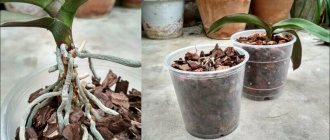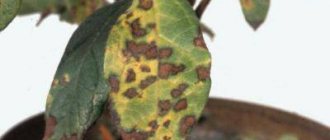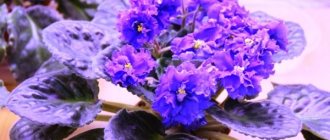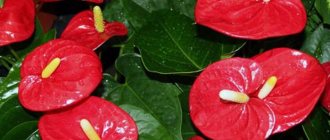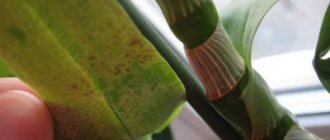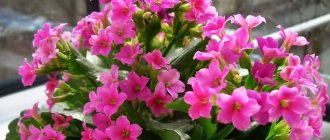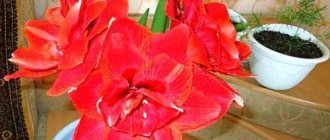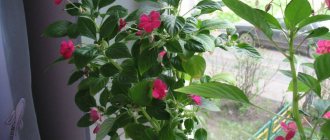Excessive "youth"
The most common phalaenopsis hybrids in home floriculture. They produce the first peduncle at the age of 1.5-3 years, when the plant already has 5-8 fully formed leaves.
In this case, the lack of flowering is not associated with any problems, you just need to wait.
If a peduncle appears on a very young orchid, it is cut off. She definitely won’t have enough strength to grow and bloom at the same time, she will seriously weaken, and may even die.
Incorrect lighting
Both the lack of light and the lack of protection from direct sunlight (especially in summer, during the hottest time of day) are to blame for the lack of flowering. In the first case, the plant cannot develop normally; in the second, it gets sunburned.
For regular flowering, it needs at least 10-12 hours of daylight at any time of the year. The place for the pot is chosen so that diffused light hits the plant from the side. The window sill of an east or west window is also good.
If the plant does not have enough light in winter, it will not form a flower stalk. To ensure the required duration of daylight hours, phytolamps are used.
Low humidity and temperature
The orchid is originally a tropical plant. Its homeland is characterized by high air humidity (70-80%) and temperatures of 25-30°C in summer and 20-23°C in winter. A necessary condition for flowering is a difference between day and night temperatures of 5-7°C.
Since it cannot be sprayed, air humidity is increased using:
- special humidifier devices;
- “company” of other plants;
- containers with cool water placed around the room;
- strips of damp sphagnum moss wrapped around a pot or placed in a tray, coconut fiber.
In winter, the pots are moved away from radiators and other heating devices that dry out the air greatly.
Substrate of poor quality
For cultivation, a substrate is used, consisting mainly of pieces of pine bark. Other ingredients are peat chips, sand, pieces of charcoal, chopped dry sphagnum moss, fine expanded clay, even polystyrene foam.
Ordinary soil for indoor plants is not suitable for orchids due to its high moisture capacity and “oversaturation” with minerals. In such conditions, root rot develops quickly and the plant will not bloom.
To form a peduncle, it must be transplanted into a substrate of suitable quality. During the transplantation process, be sure to inspect the roots and cut out all dead tissue affected by rot.
I recommend watching the video (be sure to watch it to the end), you will learn a lot of new things:
The orchid has leaves on its peduncle, not flowers, what are they?
Your orchid has bloomed and you notice that something strange is happening to the peduncle.
For most people, after flowering, new stems with buds may form on the peduncle, and children may also appear. If you have never seen orchid babies and don’t yet know what they look like, then I hasten to reassure you, because when the babies appear, you will not be able to help but notice it. Usually, one to several new small plants with their own leaves begin to develop on the peduncle. At first, the roots of the new sprouts are not visible, but gradually the roots begin to grow.
And if you notice that a shoot has appeared on the orchid’s peduncle, then your joy will know no bounds. In any case, I was jumping up and down for joy. To be honest, back then I didn’t believe at all that this could happen to me. But life is such a thing and it often presents such pleasant surprises.
In my case, the baby appeared on the stem (peduncle), but it also happens that the orchid produces a shoot at the base of the root collar. Unfortunately, I haven’t had such a phenomenon yet and I don’t know what such a process looks like, but for sure it will immediately become noticeable. My further article will be devoted to how to separate and plant the baby orchid that has formed on the stem.
The babies develop on the mother plant for about 6 months. During this time, about five leaves grow on it and roots form. When the roots grow to 5 cm or more, they can be separated from the mother plant and planted in a new pot.
However, it also happens that a baby orchid does not take root for a long time. In this case, it is better not to do anything and not interfere with the natural process. Some sources advise attaching moss to baby orchids, or creating a hanging mini greenhouse. This process is very troublesome and does not always lead to the expected result.
Errors in watering
For normal development, and therefore flowering, of any epiphyte, proper watering is necessary. Orchids react negatively to both “drought” and “swamp” in a pot. When determining the intervals between waterings, they are guided by the condition of the substrate and roots. The first one should dry completely, the second one will develop a silver-gray “patina”.
If there are no other problems, it is enough to adjust the watering. The substrate is moistened by immersion, leaving the pot in a basin of water for 1.5-2 hours. You don’t need to pour too much, just cover the bottom third of the container. Then the excess water must be drained.
Watering is carried out exclusively with warm (40-45°C) water.
The orchid has leaves on its peduncle, what should I do? Manifestation of diseases
If the reason for the appearance of sticky drops is not due to pest infestation or excess moisture and is not a natural process, it is worth considering. The fact is that some infectious diseases can also manifest themselves in this way.
Among the most common and dangerous diseases are powdery mildew and gray mold.
Causes of defeat
Whitish sticky spots along the edges of the leaves and on the peduncle are a clear indicator of the development of powdery mildew, but if mold begins to form at the base of the peduncle, this is a sign of infection with gray rot.
There may be several reasons for the defeat. These include the familiar problems of dry air and excessively wet soil.
Remedies
In order to eliminate the cause of the disease, it is necessary to check the soil moisture and, if necessary, dry it. It wouldn't hurt to lower the air temperature. In addition, it is very important to monitor the ambient humidity.
In addition to following the rules for keeping orchids, it is necessary to periodically treat them with biological products for preventive purposes. “Fitosporin” is considered to be the most effective.
Inappropriate fertilizers or lack of fertilizing
Universal fertilizers for indoor plants, and even more so folk remedies for orchids, are strictly contraindicated. They need specialized feeding.
Phosphorus is required for the formation of flower stalks, so its presence in the composition is mandatory. With an excess of nitrogen, it “fattens”, increasing green mass, but does not bloom. She needs fertilizers with a minimum concentration of this macronutrient.
Fertilizing is combined with watering, dissolving the fertilizer in water. They are carried out no more than once every two weeks.
Caring for the plant before and after the appearance of the arrow
Cultivation of a flower until a shoot appears in the standard way :
In order for a healthy peduncle to grow, it is necessary to create suitable conditions.
When a flower shoot appears, the conditions change slightly and you need to pay attention to the parameters described below for caring for the orchid.
Reducing the watering schedule
Watering begins to be reduced as soon as the arrow begins to develop. But this does not mean that the flower should be overdried.
When a flower stalk appears, it is necessary to reduce watering.
We just leave between waterings not 2-3 days of drying, but 5. That is, if watering was once a week, now it is watered once every 2 weeks.
Features of fertilizing
When a flower shoot appears, fertilizing is slightly reduced . And when the buds begin to form, they stop altogether. Because fertilizing greatly shortens the flowering period.
Lighting and temperature
If the arrow began to form in the autumn-winter period, the flower is placed on a windowsill in a southern direction .
If it is not there, then you need to take care of additional lighting, since without sufficient lighting the shoot will not develop. The air temperature in the room for proper development should be between 23-26 degrees Celsius . Cold weather may well slow down development and, if measures are not taken, the shoot will begin to dry out.
Root rot
Any plant with roots affected by rot will definitely not bloom. The development of rot is most often caused by regular waterlogging of the soil in combination with low indoor temperatures. The substrate in the pot becomes covered with a layer of mold and gives off an unpleasant odor.
To assess the extent of the problem, you need to remove the plant from the pot and clean the roots from the soil. Rotted tissues are black or dark brown and slimy to the touch.
They are cut off with a sharp, disinfected knife, the “wounds” are washed with a bright pink solution of any fungicide or potassium permanganate (potassium permanganate) and sprinkled with sifted wood ash, powdered activated carbon or chalk.
1.5-2 hours after the “operation” the plant is transplanted into a fresh substrate and a new pot. You can’t expect it to bloom quickly; the plant needs time to recover.
Baby orchid on a dry peduncle. A baby appears on an orchid peduncle - what to do?
Having received a beautiful specimen in his possession, the gardener often thinks about what a miracle it is. One way is to obtain it from the peduncle of an orchid after it blooms. However, raising such a child is far from the easiest task.
If a baby does appear on an orchid peduncle, what to do and how to deal with it correctly? This is what we will discuss further in our article.
In order for a baby to appear, certain growing conditions are required, namely:
- high humidity;
- quite a lot of diffused sunlight;
- The ambient temperature is not less than 25-27 degrees Celsius.
If these conditions are created for the flower, then soon after flowering you can expect the appearance of babies.
IMPORTANT! If the humidity is low, then the lateral peduncle will grow instead of the children.
Appearance
At the first sign of growth of a waiting bud, impatient flower growers want to know how to determine whether a flower stalk or a baby has emerged from it. Experienced flower growers will help here; they are of the opinion that on the 5th day the growing peduncle has a sharp growth tip, and a rounded one.
But it will be completely clear what came out of the waiting bud on the 10-15th day.
Photo
Below you can see several photos of the baby on a peduncle. First, a rosette of young leaves develops, and then roots will appear.
Caring for the mother plant
Many gardeners believe that an orchid cannot be grown with the help of a child. This confidence is created in them because they do not have the right conditions for the appearance of a young shoot and they do not know how to get a baby from a peduncle.
First of all, you need to choose the right time. It occurs in the spring of post-growth. The peduncle is shortened to the upper waiting bud, cutting it 2 cm higher. This is done with pruning shears, after which the cut is dried and covered with garden varnish.
Basic conditions for the birth of a baby:
- humidity - it is increased with the help of containers with water, or you can choose the wettest place in the apartment, where it is warm and humid, this is the kitchen. Food is often cooked there, which increases the humidity and temperature;
- lighting - if the room is located on the north side, then in the spring for the education of the child you will need
- – must be applied to orchid plants with a higher proportion of nitrogen components necessary for the development of the baby.
I would like to remind you that the mother plant itself must have an absolutely healthy appearance before propagation begins and must not have pests on it. Then the orchid is trimmed and placed in a damp, warm place with sufficient lighting.
Watering is done as needed warm and soft. And don’t forget to add it, because nitrogen is necessary for the formation of new cells and the growth of a young baby.
IMPORTANT! For the baby to appear, it is necessary to create the necessary conditions for the mother plant.
Stimulation with hormonal paste
If the baby appears on the mother plant on a faded peduncle, then they leave it and help the bush to grow the baby on itself. If all maintenance conditions are met and the plant is healthy, and the baby does not appear from the peduncle, you can use hormonal paste.
To do this, remove the covering tissue from the waiting bud and slightly injure it with a sterile needle. After which it is applied to the kidney using a needle or match. After 10 days, a shoot will begin to develop.
Stimulation with cytokinin paste.
IMPORTANT! To increase the humidity, you can wrap the waiting bud in cellophane, leaving an air flow.
Children's department
Deadlines
From the moment the baby appears on the peduncle until the time when it is ready, at least six months pass. Sometimes she will need more time.
It depends on how much energy the mother plant has, what time of year the babies appeared and how many of them were formed on one bush. After all, we must remember that it is difficult for an average orchid bush to grow even 3 children on its peduncles.
Readiness
The florist, having received a baby for the first time and raised it to a certain size, wonders whether she is ready for?
First of all, you need to pay attention to the fact that there are 2-3 roots and reach a length of 5 cm. At the same time, there should be 4 roots on the young rosette. young leaves.
If all this is available, then the baby is ready to be separated from the mother plant.
When should you not do this?
If the baby has not reached a certain size or its root system is in its infancy, then it cannot be separated from the main bush, since it may not survive on its own. Only if it breaks off due to carelessness or the main bush dies, you can try to save it by growing it in a greenhouse, but this does not always give a positive result.
Therefore, it is advisable to leave the bush on the mother plant as long as possible in order to obtain the correct size necessary for the survival of the young orchid. Next, we will tell you how to separate a grown bush from its mother.
Trimming
The process of trimming a baby is not at all complicated, but you should pay attention to certain points. It is necessary to cut so that the remains of the peduncle on both sides are no more than 2 cm.
You cannot unscrew a young socket, since you can say with great confidence that when unscrewing it will be damaged.
Baby after separation.
Tools
The best tool for this is considered to be a garden pruner, since its cut quickly heals on flower branches. But we must remember that after each cut the pruning shears must be treated with alcohol. This is done so that if one plant is infected, the entire collection does not become infected.
In the absence of a sector, you can use:
- scalpel;
- scissors.
IMPORTANT! It is not recommended to cut with a knife, as there is a risk of damaging the baby.
How and where to plant a young plant?
A container of a certain type and size should be the size of the root system and be selected from small fractions and add a little sphagnum moss.
If there are practically no roots, and the baby has already been separated, then it is planted in a moist plant, placed on the bottom, and the baby is secured above it in such a way that the roots are 2 cm short of the moss.
They will grow, stretching towards the moisture.
Technology
Using a sharp pruner, cut off the peduncle with the baby and leave it for 2-3 hours to dry the cuts. After which the sections are treated with one of the antiseptics:
- activated carbon;
- wood ash;
- cinnamon.
The process of how to remove a baby from a peduncle:
- In a selected plastic container (you can use a plastic glass, having previously made holes in it from the bottom) pour 2-3 cm of bark, which will serve as drainage;
- Then the baby is placed so that its root system is at the level of the upper edge of the container. If 3 cm of bark is not enough, you need to add more;
- When adding bark, do not compact it, but leave gaps with air pockets;
- You can put sphagnum moss as a top layer, but it should not touch the rosette and leaves.
Baby orchid after planting.
The plant is not watered for 3 days, allowing small cracks that may have appeared in the root system to heal.
Aftercare
After the young rosette is planted, it is cared for in the same way as for an adult plant. It will just be done more often, since the small container dries out quite quickly.
Growing a child's root system
Sometimes, for some reason, the baby orchid plant lacks root mass. In this case, you need to help the orchid with their growth.
On the mother plant
If the baby has no roots, but it still grows on a peduncle, you can help the plant grow them.
To do this, using an elastic band or thread, carefully secure the sphagnum moss on the peduncle 3-4 cm below the child without roots. And as it dries, we moisten the moss. By doing this we increase the amount of moisture, and the roots will be forced to appear and stretch towards the wet moss.
Growing roots with sphagnum moss.
IMPORTANT! The moss will dry differently depending on the room temperature. In summer it can dry out within 24 hours. But when moisturizing it, you must remember that you should not spray it on the baby, as rot may occur in its leaf axils.
After her separation
The separated baby can be placed in a plastic or glass glass, at the bottom of which there will be moss. It should be constantly moist and this will help the baby grow its root mass. If there is not enough humidity in the room, then this glass is placed in a transparent plastic bag.
Possible problems and risks
Problems may arise if an inexperienced gardener begins to break it out, thereby damaging the outlet. If you carefully cut it and process the cuts, then there will be no problems with the young rosette when replanting. It is also important to follow the rule of the first watering and carry it out for the first time on the 3rd day.
Useful
Video answers to some questions about orchid babies on a peduncle: Watch a video about what to do with a baby on a peduncle: From this video you will learn how to separate a baby: The following video demonstrates the use of cytokinin paste to produce babies:
Conclusion
Reproduction with the help of children is the easiest way to create your own orchid. There is nothing complicated in the process itself, you just need to fulfill all the requirements for separating and replanting the young plant.
Other diseases and pests
If an orchid is literally “fighting for life,” it will definitely not bloom. The list of diseases and pests typical of this plant is quite long. Therefore, you need to be able to identify the problem and know what to do in each specific case.
To notice the development of a disease or pest attack at an early stage, when it is easier to cope with the problem, it is recommended to inspect the plants once every 5-7 days.
Having discovered characteristic symptoms, the most severely affected parts of the plant are disposed of, if possible, then the “pet” is treated with a suitable chemical - a fungicide, insecticide, acaricide.
Orchids are deservedly considered delicate, capricious and demanding plants to care for. Their “fragility” and “vulnerability” requires the provision and maintenance of a specific microclimate and competent care. Otherwise, you may not expect flowering. It is also necessary to take into account the development cycle - buds will not appear at the “inopportune” time, despite all your efforts.
How to distinguish from other parts
It is quite easy to distinguish the peduncle from the root. To do this, you should pay attention to the following features:
- the whitish root has a salad end and is placed on the neck or stem to the side of the leaf;
- The peduncle has a darker color and develops from the leaf axil.
Orchid leaves: main diseases and methods of combating them
To distinguish a peduncle from a baby, you also need to take into account some features. At the beginning of development, the baby has the same bud as the branch. Moreover, it has a fairly blunt end, since leaves are subsequently formed from it.
Important! At the initial stage, it can be difficult to identify differences. However, after a couple of weeks you will be able to see an elongated shoot or dense leaves that will appear from a dormant bud.

